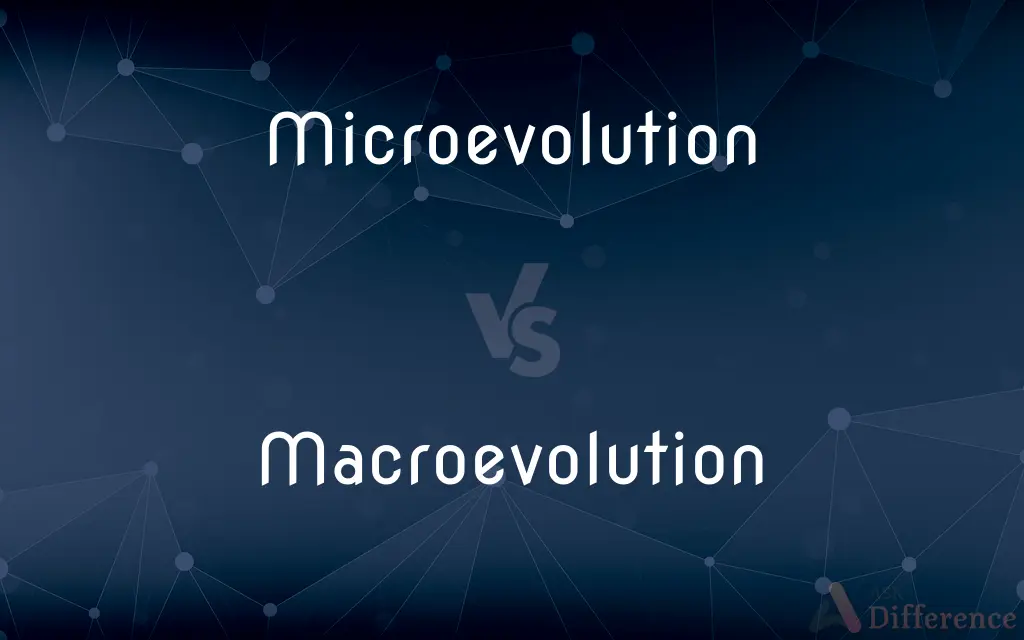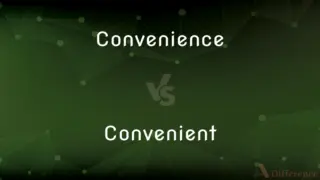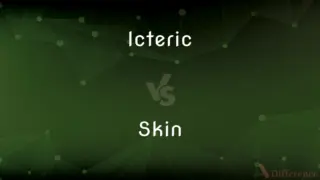Microevolution vs. Macroevolution — What's the Difference?
Edited by Tayyaba Rehman — By Fiza Rafique — Updated on October 5, 2023
"Microevolution" refers to small evolutionary changes within a species, while "macroevolution" involves larger-scale changes leading to new species over geologic time.

Difference Between Microevolution and Macroevolution
Table of Contents
ADVERTISEMENT
Key Differences
"Microevolution" encompasses subtle genetic changes within a population or species, often driven by natural selection, gene flow, or genetic drift. "Macroevolution," in contrast, describes the broader patterns of evolutionary change leading to new species, genera, or even more extensive taxonomic groups over extended periods.
The primary distinction lies in the scale. While microevolutionary changes can be observed over shorter periods (even within a few generations), macroevolutionary shifts are discernible over long geological time scales, often millions of years.
Factors like mutations, genetic drift, and selection pressures often influence microevolution. Macroevolution, while building on microevolutionary processes, is shaped by broader events like speciation, extinction, and adaptive radiation.
Variations in beak size among finches in response to food availability is a case of microevolution. The evolution of birds from theropod dinosaurs is an example of macroevolution.
In the study of evolution, microevolution provides insights into the immediate adaptive mechanisms of organisms, while macroevolution offers a larger perspective on the diversification and relationships between major life forms.
ADVERTISEMENT
Comparison Chart
Definition
Small-scale genetic changes within a population or species.
Large-scale evolutionary changes leading to new species or broader taxonomic groups.
Timescale
Short-term (few generations to thousands of years).
Long-term (millions to billions of years).
Drivers
Mutations, selection, gene flow, genetic drift.
Speciation, extinction, adaptive radiation.
Results in
Variations within species.
New species, genera, families, etc.
Study
Population genetics, ecological genetics.
Paleontology, systematics, phylogenetics.
Compare with Definitions
Microevolution
Small-scale modifications due to natural selection or other processes.
The differing wing colors in a moth population are driven by microevolution.
Macroevolution
Evolutionary change leading to new species or broader taxonomic groups.
The emergence of mammals from reptile-like ancestors is a macroevolutionary event.
Microevolution
Alterations in allele frequencies within a population.
Microevolution explains the variation in a trait within a single species.
Macroevolution
Broad trends of genetic change over geologic time scales.
Macroevolution encompasses the major transitions in Earth's biodiversity.
Microevolution
Evolutionary changes within a species or population.
Microevolution led to various finch beak sizes on the Galápagos Islands.
Macroevolution
Evolutionary phenomena above the species level.
The divergence of amphibians, reptiles, and birds demonstrates macroevolution.
Microevolution
Genetic shifts observed over short time scales.
Pesticide resistance in insects is an example of microevolution.
Macroevolution
Patterns resulting from long-term evolutionary forces and events.
The rise and fall of the dinosaurs is a macroevolutionary narrative.
Microevolution
Adaptations to immediate environmental changes.
Microevolution allows organisms to quickly adapt to changing habitats.
Macroevolution
Large-scale evolutionary patterns and processes.
The evolution of flowering plants shows macroevolution in action.
Microevolution
Microevolution is the change in allele frequencies that occurs over time within a population. This change is due to four different processes: mutation, selection (natural and artificial), gene flow and genetic drift.
Macroevolution
Macroevolution in the modern sense is evolution that is guided by selection among interspecific variation, as opposed to selection among intraspecific variation in microevolution. This modern definition differs from the original concept, which referred macroevolution to the evolution of taxa above the species level (genera, families, orders etc.).
Microevolution
Small-scale evolution consisting of genetic changes occurring usually within a single species and over a shorter period of time than in macroevolution.
Macroevolution
Large-scale evolution occurring over a very long period time that results in the formation of new species and higher-level taxonomic groups.
Microevolution
Small-scale changes in the history of life, such as changes in allele frequencies in a population (over a few generations); also known as change at or below the species level.
Macroevolution
Large-scale patterns or processes in the history of life, including the origins of novel organism designs, evolutionary trends, adaptive radiations and extinctions.
Microevolution
Evolution resulting from small specific genetic changes that can lead to a new subspecies
Macroevolution
Evolution on a large scale extending over geologic era and resulting in the formation of new taxonomic groups
Common Curiosities
Is macroevolution just extended microevolution?
While macroevolution builds on microevolutionary processes, it also involves additional mechanisms and patterns.
Can a single mutation lead to microevolution?
Yes, if a mutation provides an advantage and increases in frequency, it can drive microevolution.
Are the mechanisms driving microevolution different from macroevolution?
Some mechanisms overlap, but macroevolution also involves broader processes like speciation and extinction.
Does macroevolution always result in entirely new species?
Macroevolution encompasses the formation of new species but also includes broader evolutionary changes.
Can we observe microevolution in real-time?
Yes, microevolution can be observed within a few generations, such as antibiotic resistance in bacteria.
Is natural selection the only driver of microevolution?
No, microevolution can also result from genetic drift, mutations, and gene flow.
Does microevolution always lead to macroevolution?
Not necessarily. While microevolutionary changes can accumulate over time, they don't always result in macroevolutionary shifts.
Are microevolution and macroevolution opposing concepts?
No, macroevolution builds upon microevolutionary processes but on a broader scale.
How do scientists study macroevolution?
Through fossil records, molecular data, and reconstructing evolutionary relationships (phylogenetics).
Can environmental changes drive microevolution?
Yes, changes in the environment can lead to selection pressures that drive microevolution.
How do extinction events fit into macroevolution?
Extinction events shape macroevolution by ending lineages and allowing new ones to diversify.
Is adaptation always a result of microevolution?
Adaptation often results from microevolution, but not all microevolutionary changes are adaptive.
Are there debates about the rate of macroevolution?
Yes, there are discussions about gradualism (steady change) versus punctuated equilibrium (quick bursts of change).
Is the fossil record essential for studying macroevolution?
While the fossil record provides crucial insights, molecular data and other methods also inform macroevolutionary studies.
Can humans influence microevolution?
Yes, through activities like selective breeding and creating selective pressures (e.g., antibiotic use).
Share Your Discovery

Previous Comparison
Convenience vs. Convenient
Next Comparison
Icteric vs. SkinAuthor Spotlight
Written by
Fiza RafiqueFiza Rafique is a skilled content writer at AskDifference.com, where she meticulously refines and enhances written pieces. Drawing from her vast editorial expertise, Fiza ensures clarity, accuracy, and precision in every article. Passionate about language, she continually seeks to elevate the quality of content for readers worldwide.
Edited by
Tayyaba RehmanTayyaba Rehman is a distinguished writer, currently serving as a primary contributor to askdifference.com. As a researcher in semantics and etymology, Tayyaba's passion for the complexity of languages and their distinctions has found a perfect home on the platform. Tayyaba delves into the intricacies of language, distinguishing between commonly confused words and phrases, thereby providing clarity for readers worldwide.














































